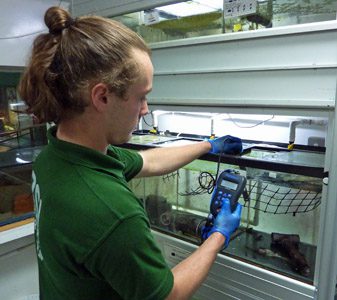
To help ensure optimum water quality for all its aquatic species, London Zoo has opted for water testing equipment from Gateshead based water and environmental test kits manufacturer Palintest. The aquarium team utilises the Photometer 7100 for monitoring chlorine, alkalinity, phosphate, ammonia, nitrite, potassium and pH. The herpetology (amphibian) team also uses the Photometer 7100, but in addition uses electrochemical testing products, including Palintest’s Micro 600 pH meter and a Micro 800 dissolved oxygen (DO) meter as part of their water quality monitoring protocol.
The feedwater for both the aquarium and herpetology sections is provided by Thames Water. This includes chlorine which must be removed before it comes into contact with any of the aquatic life. At the zoo, much of the water is treated via reverse osmosis (RO) and then remineralised to ensure control of the water quality habitats. Chlorine analysis of the feedwater prior to the RO is also critical for the protection of the RO membranes.
Aquarium water testing
Alkalinity measures how water will change with the addition of an acid or alkaline substance, which in turn can affect pH. Aquatic life is very sensitive to pH changes, so maintaining a good alkalinity level helps maintain a stable environment overall. Phosphate testing is important for coral, which is predominantly made up of calcium. At high levels phosphate prevents the uptake of calcium by the coral, so levels must be maintained below 0.1 mg/l. Ammonia is a waste product of aquatic life and is poisonous to fish. It is normally broken down to nitrite by bacteria in the water as part of the nitrogen cycle. Nitrite is also hazardous for aquatic life, so measuring both ammonia and nitrite are essential in understanding the aquatic ecosystem.
Herpetology water testing
As part of its vital conservation work, the herpetology section became the first place in the world to breed the Lake Oku Clawed Frog, an extremely rare species only found in high altitude Lake Oku in Cameroon. As the reproductive biology of the frog was unknown the keepers had to replicate the specific environmental parameters of Lake Oku.
Using the Micro 800 DO meter and the Photometer 7100, the keepers determined that the tadpoles only thrived in an unusual aquatic environment containing less than 20ppm of total dissolved solids (TDS). In their natural environment in Lake Oku, TDS levels were below 10ppm, indicating that this particular species of frog has evolved only to thrive in a single and stable environment.
Commenting on the London Zoo project, Palintest’s Marketing Manager Tom Aylward said: “It’s very rewarding to see our products being put to such important use. By ensuring a safe aquatic environment for fish and amphibians at London Zoo – and by helping to understand the life cycle of an extremely rare and endangered animal – we feel we’re playing a vital role in the Zoo’s conservation efforts.”
ZSL London Zoo has one of the largest collections of aquatic life in the UK, including some of the rarest species of fish and amphibians. This diversity creates unique water quality demands as each species often requires very specific water conditions to survive, with a slight change in conditions being potentially life-threatening. Regular, highly accurate water testing is therefore a critical part of managing the aquatic collections.






